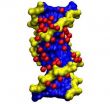(Press-News.org) Planes were grounded all over Europe when the Eyjafjallajökull volcano erupted in Iceland last year. But no one knew if the no fly zone was really necessary. And the only way to find out would have been to fly a plane through the ash cloud - a potentially fatal experiment.
Now a team of researchers from the University of Copenhagen and the University of Iceland have developed a protocol for rapidly providing air traffic authorities with the data they need for deciding whether or not to ground planes next time ash threatens airspace safety.
A study by the teams of Professors Susan Stipp from the Nano-Science Centre of the University of Copenhagen and Sigurdur Gislason from the University of Iceland is reported this week in the internationally recognized journal PNAS (Proceedings of the National Academy of Sciences, USA).
Volcanic ash could crash planes if the particles are small enough to travel high and far, if they are sharp enough to sandblast the windows and bodies of airplanes, or if they melt inside jet engines. The ash from the Eyjafjallajökull eruption was dangerous on all counts, so the authorities certainly made the right decision in April 2010. That's one conclusion from the Copenhagen/Iceland paper but Professor Stipp thinks the team's most important contribution is a method for quickly assessing future ash.
"I was surprised to find nothing in the scientific literature or on the web about characterising ash to provide information for aviation authorities. So we decided to do something about it", explains Stipp.
Some 10 million travellers were affected by the ash plume, which cost an estimated two and a half billion Euros.
"Aviation authorities were sitting on a knife-edge at the centre of a huge dilemma. If they closed airspace unnecessarily, people, families, businesses and the economy would suffer, but if they allowed air travel, people and planes could be put at risk, perhaps with tragic consequences," says Professor Stipp.
So Susan Stipp phoned her colleague and friend in Reykjavik, Siggi Gislason and while the explosive eruptions were at their worst, he and a student donned protective clothing, collected ash as it fell and sent some samples to Denmark. "In the Nano-Science Centre at the University of Copenhagen, we have analytical facilities and a research team that are unique in the world for characterising natural nanoparticles and their reaction with air, water and oil." explains Professor Susan Stipp
The newly developed protocol for assessing future ash can provide information for safety assessment in less than 24 hours. Within an hour of receiving the samples, scientists can tell how poisonous they are for the animals and people living closest to the eruption. Half a day enables them to predict the danger of sandblasting on aircraft, and assess the risk of fouling jet engines. Within a day they can tell the size of the particles, providing data for predicting where and how far the ash cloud will spread. Susan Stipp hopes that because of the analysis protocol, aviation authorities will not face such an impossible dilemma next time fine-grained ash threatens passenger safety. "Some of the analytical instruments needed are standard equipment in Earth science departments and some are commonly used by materials scientists, so with our protocol, aviation authorities ought to be able to get fast, reliable answers," concludes Professor Stipp.
INFORMATION:
Novel ash analysis validates volcano no-fly zones
Nanotech gives aviation authorities fact-based tool for air space risk assessment when volcanoes erupt
2011-04-26
ELSE PRESS RELEASES FROM THIS DATE:
Protein inhibitor may bring a topical treatment for HPV
2011-04-26
BOSTON (April 26, 2011) —Human papillomavirus (HPV) causes cervical cancer, the second most common cause of cancer death for women, and is a common cause of anogenital and some head and neck cancers. Thanks to research being done at Tufts University School of Medicine, patients infected with cancer-causing HPV may someday have an alternative to surgical and harsh chemical treatments. In a study funded by the National Institutes of Health and published online in advance of print in The FASEB Journal, the researchers report on the development of a protein-based inhibitor ...
Water molecules characterize the structure of DNA genetic material
2011-04-26
Water molecules surround the genetic material DNA in a very specific way. Scientists at the Helmholtz-Zentrum Dresden-Rossendorf (HZDR) have discovered that, on the one hand, the texture of this hydration shell depends on the water content and, on the other hand, actually influences the structure of the genetic substance itself. These findings are not only important in understanding the biological function of DNA; they could also be used for the construction of new DNA-based materials.
The DNA's double helix never occurs in isolation; instead, its entire surface is ...
Study examines folic acid absorption rates from softgel capsule and standard tablet
2011-04-26
NORTHRIDGE, CA (April 26, 2011) — Folic acid, an essential vitamin formulated to be part of a multivitamin + DHA liquid softgel capsule, is absorbed and available within the body in amounts similar to folic acid formulated for solid tablets, according to a study presented in a late breaking session at the Experimental Biology (EB) 2011 annual meeting. Different formulations, fillers and coatings of vitamin products may affect the degree or rate at which the product dissolves and releases its contents, which can alter the vitamin's absorption into the body and its bioavailability, ...
Motor protein may offer promise in ovarian cancer treatment
2011-04-26
A motor regulatory protein can block human ovarian tumor growth, leading to eventual cancer cell death and possible new therapies to treat the disease, according to Penn State College of Medicine researchers.
Among U.S. women, an estimated 21,880 new cases and 13,850 deaths occurred in 2010 from epithelial ovarian cancer, one of the most common forms of ovarian cancer and the most lethal gynecologic cancer in women.
Previously, Kathleen M. Mulder, Ph.D., professor, biochemistry and molecular biology, along with members of her laboratory, learned that km23-1 -- a protein ...
Chernobyl's radioactivity reduced the populations of birds of orange plumage
2011-04-26
On April 26, 1986, history's greatest nuclear accident took place northwest of the Ukrainian city of Chernobyl. Despite the scale of the disaster, 25 years later, we still do not know its real effects. An international team of investigators has shown for the first time that the colour of birds' plumage may make them more vulnerable to radioactivity.
Radiation causes oxidative stress, damages biological molecules and may have "important" negative effects on organisms in relatively high doses, like those found in certain zones close to Chernobyl.
"In the case of the ...
NRL scientists focus on light ions for fast ignition of fusion fuels
2011-04-26
(WASHINGTON) -- Scientists at the Naval Research Laboratory Plasma Physics Division demonstrate significant progress in the efficiency and cost effectiveness of light ions in the fast ignition of fusion targets. Light ions such as lithium or carbon are easier to produce technologically and the ion beam properties can be manipulated and tailored best to suit the necessary requirements for fast ignition.
The fast ignition concept has been conceived as an alternative to other approaches for nuclear fusion energy. In the fast ignitor scenario a high-energy particle beam, ...
Erickson Law and The Surrogacy Lawyer Radio Show Offers Free Banner Advertising and Awareness to Infertility Non-Profits In Honor of National Infertility Awareness Week, April 24-30
2011-04-26
In honor of National Infertility Awareness Week, "The Surrogacy Lawyer" Theresa M. Erickson, managing partner of Erickson Law and host of The Surrogacy Lawyer Radio Show on Voice America, announced her firm is offering free banner advertising on its radio show Website to the many infertility nonprofit organizations that offer support, advocacy and education to infertility patients.
National Infertility Awareness Week (NIAW) is being held this year from April 24-30 and is the only federally recognized week promoting education and awareness about the disease ...
Topical treatment may prevent melanoma
2011-04-26
While incidents of melanoma continue to increase despite the use of sunscreen and skin screenings, a topical compound called ISC-4 may prevent melanoma lesion formation, according to Penn State College of Medicine researchers.
"The steady increase in melanoma incidence suggests that additional preventive approaches are needed to complement these existing strategies," said Gavin Robertson, Ph.D., professor of pharmacology, pathology, dermatology and surgery, and director of Penn State Hershey Melanoma Center.
Researchers targeted the protein Akt3, which plays a central ...
New discovery could 'green up' hundreds of everyday products
2011-04-26
WASHINGTON, April 26, 2011 — The American Chemical Society (ACS) today released a new episode in its award-winning "Global Challenges/Chemistry Solutions" podcast series showcasing a discovery that could mean greener and more environmentally friendly production of a key ingredient used to make everything from paint to diapers.
The podcast and accompanying website focus on a new way to make acrylic acid, a key industrial material that's usually produced from pricey and increasingly scarce petroleum. It involves development of a new catalyst that permits production of ...
A potential novel drug-target for colorectal cancer treatment comes from the brain
2011-04-26
Porto Alegre, Brazil- Tumor progression is usually ensured by more than one proliferative mechanism. When one of these is shut down by a specifically targeted drug, other mechanisms may emerge. While these events may lead to treatment failure, they may also become an opportunity for researchers to identify novel targets to be further explored. In a paper recently published in the journal Oncology ("BDNF/TrkB content and interaction with gastrin-releasing peptide receptor blockade in colorectal cancer," Vol. 79, pages 430-439, 2011; DOI: 10.1159/000326564) Roesler and colleagues ...
LAST 30 PRESS RELEASES:
First Editorial of 2026: Resisting AI slop
Joint ground- and space-based observations reveal Saturn-mass rogue planet
Inheritable genetic variant offers protection against blood cancer risk and progression
Pigs settled Pacific islands alongside early human voyagers
A Coral reef’s daily pulse reshapes microbes in surrounding waters
EAST Tokamak experiments exceed plasma density limit, offering new approach to fusion ignition
Groundbreaking discovery reveals Africa’s oldest cremation pyre and complex ritual practices
First breathing ‘lung-on-chip’ developed using genetically identical cells
How people moved pigs across the Pacific
Interaction of climate change and human activity and its impact on plant diversity in Qinghai-Tibet plateau
From addressing uncertainty to national strategy: an interpretation of Professor Lim Siong Guan’s views
Clinical trials on AI language model use in digestive healthcare
Scientists improve robotic visual–inertial trajectory localization accuracy using cross-modal interaction and selection techniques
Correlation between cancer cachexia and immune-related adverse events in HCC
Human adipose tissue: a new source for functional organoids
Metro lines double as freight highways during off-peak hours, Beijing study shows
Biomedical functions and applications of nanomaterials in tumor diagnosis and treatment: perspectives from ophthalmic oncology
3D imaging unveils how passivation improves perovskite solar cell performance
Enriching framework Al sites in 8-membered rings of Cu-SSZ-39 zeolite to enhance low-temperature ammonia selective catalytic reduction performance
AI-powered RNA drug development: a new frontier in therapeutics
Decoupling the HOR enhancement on PtRu: Dynamically matching interfacial water to reaction coordinates
Sulfur isn’t poisonous when it synergistically acts with phosphine in olefins hydroformylation
URI researchers uncover molecular mechanisms behind speciation in corals
Chitin based carbon aerogel offers a cleaner way to store thermal energy
Tracing hidden sources of nitrate pollution in rapidly changing rural urban landscapes
Viruses on plastic pollution may quietly accelerate the spread of antibiotic resistance
Three UH Rainbow Babies & Children’s faculty elected to prestigious American Pediatric Society
Tunnel resilience models unveiled to aid post-earthquake recovery
Satellite communication systems: the future of 5G/6G connectivity
Space computing power networks: a new frontier for satellite technologies
[Press-News.org] Novel ash analysis validates volcano no-fly zonesNanotech gives aviation authorities fact-based tool for air space risk assessment when volcanoes erupt



